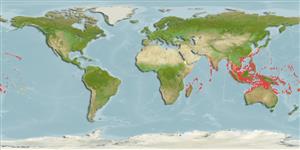Environment: milieu / climate zone / depth range / distribution range
Ecologia
marino; acqua dolce; salmastro associati a barriera corallina; distribuzione batimetrica 1 - 50 m (Ref. 57343), usually 20 - 50 m (Ref. 9685). Tropical; 34°N - 23°S, 50°E - 148°W (Ref. 57343)
Indo-Pacific: mainly around oceanic islands. Known from Mauritius, Seychelles, Kenya and many islands of the northern Indian Ocean; then from Indonesia north to the Ryukyu, Ogasawara and Yaeyama islands and east to the Hawaiian Islands, French Polynesia and Pitcairn. Has not been collected in Australia (Ref. 57343).
Size / Peso / Age
Maturity: Lm ? range ? - ? cm
Max length : 61.0 cm TL maschio/sesso non determinato; (Ref. 4887); peso massimo pubblicato: 3.2 kg (Ref. 4699)
Spine dorsali (totale): 9; Raggi dorsali molli (totale): 13; Spine anali 3; Raggi anali molli: 11. Body uniformly golden silver; occasionally with several faint dark stripes along longitudinal scale rows above and below lateral line. Pectoral filaments 6 with tip of uppermost filament reaching to or slightly beyond level of posterior tip of upper part of pectoral fin (Ref. 41110).
This schooling species occurs along sandy and rocky shorelines and over sandy lagoon bottoms, often in zones of turbulence (Ref. 9685). Benthopelagic (Ref. 58302). Often encountered in river mouths or brackish mangrove estuaries. Feeds mainly on crustaceans (shrimps and crabs), polychaete worms, other benthic invertebrates; also on teleosts (Ref. 9685). A lunar spawning rhythm occurs close to shore (Ref. 9685). Sexual maturity in males occurs at 12 to 15 cm (Ref. 9685). Subsequently undergoes sex reversal passing through a hermaphroditic stage, and become female between 18 and 24 cm (Ref. 9685). The potential of this species for aquaculture has been studied (Ref. 9685).
Life cycle and mating behavior
Maturità | Riproduzione | Deposizione | Uova | Fecundity | Larve
Motomura, H., 2004. Threadfins of the world (Family Polynemidae). An annotated and illustrated catalogue of polynemid species known to date. FAO Spec. Cat. Fish. Purp. Rome: FAO. 3:117 p. (Ref. 57343)
IUCN Red List Status (Ref. 130435)
Threat to humans
Harmless
Human uses
Pesca: commerciale; Acquacoltura: sperimentale; Pesce da pesca sportiva: si; Acquario: Commerciale
Informazioni ulteriori
Nomi ComuniSinonimiMetabolismoPredatoriEcotossicologiaRiproduzioneMaturitàDeposizioneSpawning aggregationFecundityUovaEgg development
BibliografiaAcquacolturaProfilo di acquacolturaVarietàGeneticaElectrophoresesEreditarietàMalattieElaborazioneNutrientsMass conversion
CollaboratoriImmaginiStamps, Coins Misc.SuoniCiguateraVelocitàModalità di nuotoArea branchialeOtolithsCervelliVista
Strumenti
Special reports
Download XML
Fonti Internet
Estimates based on models
Preferred temperature (Ref.
123201): 24.1 - 29, mean 27.9 °C (based on 1038 cells).
Phylogenetic diversity index (Ref.
82804): PD
50 = 0.5000 [Uniqueness, from 0.5 = low to 2.0 = high].
Bayesian length-weight: a=0.01820 (0.01045 - 0.03170), b=3.11 (2.96 - 3.26), in cm total length, based on LWR estimates for this species & (Sub)family-body (Ref.
93245).
Trophic level (Ref.
69278): 3.4 ±0.49 se; based on food items.
Resilienza (Ref.
120179): Medio, tempo minimo di raddoppiamento della popolazione 1.4 - 4.4 anni (Preliminary K or Fecundity.).
Fishing Vulnerability (Ref.
59153): Moderate vulnerability (44 of 100).
Nutrients (Ref.
124155): Calcium = 38.5 [16.0, 64.6] mg/100g; Iron = 0.484 [0.247, 0.933] mg/100g; Protein = 19.8 [18.0, 21.6] %; Omega3 = 0.111 [0.072, 0.175] g/100g; Selenium = 37.4 [19.5, 80.0] μg/100g; VitaminA = 31.6 [8.9, 109.8] μg/100g; Zinc = 1.02 [0.68, 1.55] mg/100g (wet weight);
